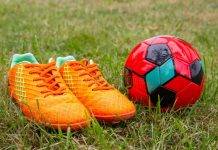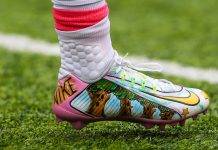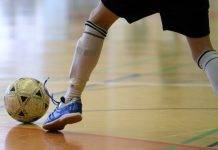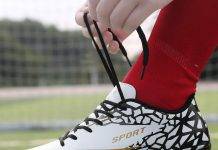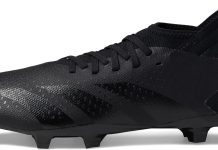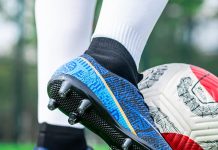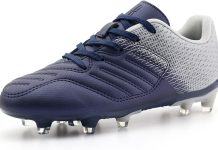In the world of soccer, choosing the right footwear can make all the difference in performance on the field. When it comes to soccer turf shoes and cleats, understanding the subtle differences between the two is crucial. Both options provide various advantages and are designed to optimize traction, stability, and maneuverability, but knowing which one suits your playing style and the type of surface you’ll be playing on can greatly impact your overall game. So let’s explore the distinctions between soccer turf shoes and cleats and help you make an informed decision for your next match.
Material
Review contents
Turf Shoes
Turf shoes are typically made with a combination of synthetic materials, such as synthetic leather or mesh, and rubber or plastic components. The synthetic leather provides durability and helps to protect the foot, while the mesh allows for breathability and flexibility. The rubber or plastic components in the outsole provide traction on artificial turf surfaces.
Cleats
Cleats, on the other hand, are usually made with genuine leather or synthetic materials. Genuine leather cleats offer excellent durability, flexibility, and a comfortable fit. Synthetic materials, on the other hand, are often more affordable and can still provide good performance. Cleats also have metal or plastic studs or blades on the outsole, which help to improve traction on natural grass surfaces.
Outsole Design
Turf Shoes
Turf shoes typically have a unique outsole design that is specifically engineered for traction on artificial turf surfaces. The outsole is made of rubber or plastic studs that are shorter and more numerous compared to cleats. This design allows for better grip and stability on the turf, preventing slips and falls.
Cleats
Cleats have longer studs or blades on the outsole, which are designed to penetrate natural grass surfaces. The length and shape of the studs can vary depending on the playing conditions, such as wet or dry grass. The primary purpose of the outsole design in cleats is to provide traction, allowing players to change direction quickly and safely on the field.
Traction
Turf Shoes
Turf shoes excel in providing traction on artificial turf surfaces. The numerous short studs or small rubber nubs efficiently grip the turf, allowing players to make quick movements without losing their balance. The design of the outsole, combined with the materials used, ensures that players can confidently maneuver on the turf without the fear of slipping.
Cleats
Cleats are specifically designed to offer optimal traction on natural grass surfaces. The longer studs or blades dig into the ground, providing stability and preventing players from sliding around. The varying length and arrangement of the studs allow for better grip on different field conditions, such as wet or muddy grass.
Playing Surface
Turf Shoes
Turf shoes are specifically designed for use on artificial turf surfaces. These surfaces are typically made of synthetic materials, such as rubber or plastic fibers, which imitate the feel and playing characteristics of natural grass. Turf shoes have the advantage of being able to provide excellent traction on these surfaces without damaging or tearing the turf.
Cleats
Cleats are primarily used on natural grass surfaces. These surfaces can vary in their conditions, from dry and firm to wet and soft. Cleats with longer studs are better suited for wet or muddy fields, as they provide better grip and prevent players from getting stuck in the turf. Depending on the regulations of the league or competition, certain types of cleats may not be allowed on specific playing surfaces to prevent damage.
Comfort
Turf Shoes
Turf shoes are often praised for their comfort and versatility. The combination of synthetic leather and mesh materials allows for breathability, keeping the feet cool during intense gameplay. The flexibility of the materials and the cushioning in the midsole provide a comfortable fit and reduce the risk of blisters or discomfort.
Cleats
Cleats, especially those made with genuine leather, offer a high level of comfort. The leather molds to the shape of the foot, providing a snug and personalized fit. Cleats also often feature additional cushioning in the midsole for added comfort during long matches or training sessions. However, it’s important to ensure the cleats are properly broken in to avoid discomfort or blisters.
Support and Stability
Turf Shoes
Turf shoes offer moderate support and stability to the players. The synthetic materials used in the upper provide a secure fit and prevent excessive movement of the foot inside the shoe. The outsole design with shorter studs or rubber nubs ensures stability on the turf, reducing the risk of ankle sprains or other injuries.
Cleats
Cleats, especially those with a high-top design, provide excellent support and stability to the players. The upper, whether made of genuine leather or synthetic materials, holds the foot securely, minimizing the risk of twisting or rolling the ankle. The longer studs on the outsole also contribute to stability, providing a solid base for quick cuts, turns, and changes in direction.
Versatility
Turf Shoes
Turf shoes are incredibly versatile and can be used on various surfaces besides artificial turf. They can also be worn on hard, dry, or firm natural grass fields, ensuring good traction without damaging the playing surface. Additionally, turf shoes are suitable for training on indoor turf surfaces, making them a popular choice among players who participate in different types of soccer games.
Cleats
Cleats are primarily designed for use on natural grass fields, although they can also be used on some artificial turf surfaces. However, using cleats on hard or concrete surfaces may cause discomfort or damage to both the shoes and the playing surface. Therefore, it is recommended to use cleats exclusively on natural grass fields, where their design and functionality are optimized.
Durability
Turf Shoes
Turf shoes are built to withstand the demands of gameplay on artificial turf surfaces. The synthetic materials used are durable and resistant to abrasion, ensuring that the shoes can withstand regular use without showing signs of wear and tear. Additionally, the outsole design with shorter studs or rubber nubs is less prone to damage compared to longer metal or plastic studs found on cleats.
Cleats
Cleats, particularly those made with genuine leather, are known for their durability. The leather material is sturdy and can withstand the rigors of playing on natural grass fields. However, the studs on the outsole, especially if they are made of plastic or metal, may need to be replaced periodically if they become worn down. Regular maintenance, such as cleaning and conditioning the leather, can help prolong the lifespan of cleats.
Price
Turf Shoes
Turf shoes are generally more affordable compared to cleats, making them a popular option for players on a budget. The use of synthetic materials in the construction helps reduce the production cost, resulting in a lower retail price. However, there are also high-end turf shoes available on the market that offer advanced features and materials at a higher price point.
Cleats
Cleats tend to be more expensive than turf shoes due to the use of higher-quality materials, such as genuine leather. The manufacturing process, including the incorporation of metal or plastic studs, also adds to the cost. While there are more affordable cleat options available, premium models that feature advanced technologies or designs can come with a higher price tag.
Rules and Regulations
Turf Shoes
Turf shoes are generally allowed in most soccer leagues and competitions, including those played on artificial turf surfaces. However, it’s important to review the specific rules and regulations of the league or organization to ensure that turf shoes are permitted. Some leagues may have restrictions on the type of studs or outsole design allowed to prevent damage to the artificial turf.
Cleats
Cleats are the traditional choice for playing soccer on natural grass fields and are widely accepted in most leagues and competitions. However, it is essential to check the rules and regulations regarding the type and length of studs permitted. Certain leagues may have restrictions on metal studs or require a maximum stud length to ensure player safety and prevent damage to the playing surface.
In conclusion, the difference between soccer turf shoes and cleats lies in their material, outsole design, traction, suitability for different playing surfaces, comfort, support and stability, versatility, durability, price, and adherence to rules and regulations. Turf shoes are specifically designed for artificial turf surfaces, with shorter rubber or plastic studs providing excellent traction and stability. Cleats, on the other hand, are intended for natural grass fields, featuring longer studs or blades that penetrate the ground for optimal grip. Turf shoes offer versatility and can be used on multiple surfaces, while cleats excel in providing comfort and support. The choice between turf shoes and cleats ultimately depends on the playing surface, personal preference, and specific regulations of the league or competition.



